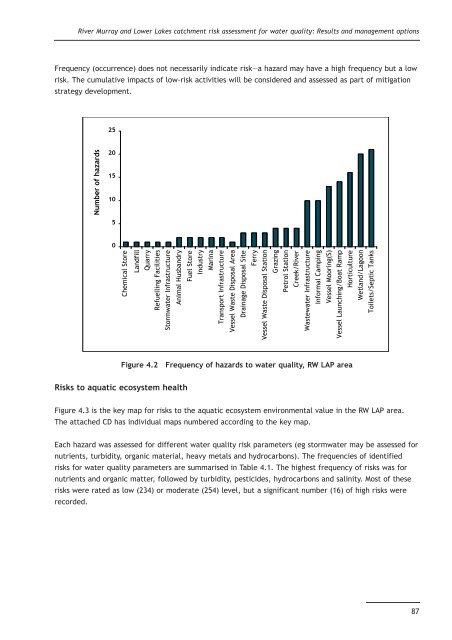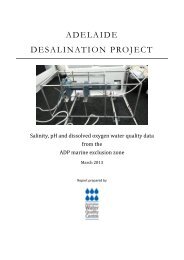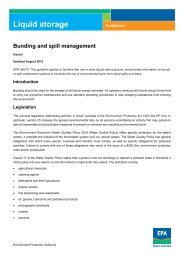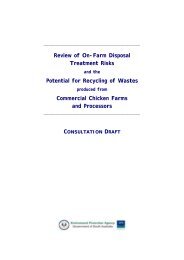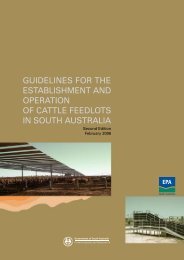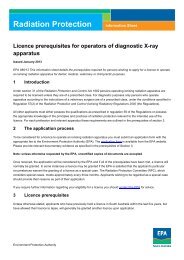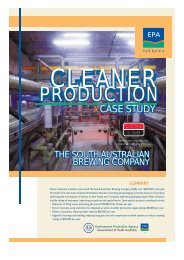- Page 1:
E N V I R O N M E N T P R O T E C T
- Page 4 and 5:
The River Murray and Lower Lakes ca
- Page 6 and 7:
6 Mannum to Wellington LAP area ass
- Page 8 and 9:
Table 6.5 Frequency of risk to recr
- Page 10 and 11:
Figure 7.2 Example of hazard to wat
- Page 12 and 13:
Roz Becker, Riverland Tourism Assoc
- Page 14 and 15:
Abbreviations 10 ADWG Australian Dr
- Page 17:
Executive Summary The River Murray
- Page 20 and 21:
River Murray and Lower Lakes catchm
- Page 22 and 23:
River Murray and Lower Lakes catchm
- Page 24 and 25:
River Murray and Lower Lakes catchm
- Page 26 and 27:
River Murray and Lower Lakes catchm
- Page 28 and 29:
River Murray and Lower Lakes catchm
- Page 30 and 31:
River Murray and Lower Lakes catchm
- Page 32 and 33:
River Murray and Lower Lakes catchm
- Page 34 and 35:
River Murray and Lower Lakes catchm
- Page 36 and 37:
River Murray and Lower Lakes catchm
- Page 38 and 39:
River Murray and Lower Lakes catchm
- Page 40 and 41: River Murray and Lower Lakes catchm
- Page 42 and 43: River Murray and Lower Lakes catchm
- Page 44 and 45: River Murray and Lower Lakes catchm
- Page 46 and 47: River Murray and Lower Lakes catchm
- Page 48 and 49: River Murray and Lower Lakes catchm
- Page 50 and 51: River Murray and Lower Lakes catchm
- Page 52 and 53: River Murray and Lower Lakes catchm
- Page 54 and 55: River Murray and Lower Lakes catchm
- Page 56 and 57: River Murray and Lower Lakes catchm
- Page 58 and 59: River Murray and Lower Lakes catchm
- Page 60 and 61: River Murray and Lower Lakes catchm
- Page 62 and 63: River Murray and Lower Lakes catchm
- Page 64 and 65: River Murray and Lower Lakes catchm
- Page 66 and 67: River Murray and Lower Lakes catchm
- Page 68 and 69: River Murray and Lower Lakes catchm
- Page 70 and 71: River Murray and Lower Lakes catchm
- Page 72 and 73: River Murray and Lower Lakes catchm
- Page 74 and 75: River Murray and Lower Lakes catchm
- Page 76 and 77: River Murray and Lower Lakes catchm
- Page 78 and 79: River Murray and Lower Lakes catchm
- Page 80 and 81: River Murray and Lower Lakes catchm
- Page 82 and 83: River Murray and Lower Lakes catchm
- Page 84 and 85: River Murray and Lower Lakes catchm
- Page 86 and 87: River Murray and Lower Lakes catchm
- Page 88 and 89: River Murray and Lower Lakes catchm
- Page 92 and 93: River Murray and Lower Lakes catchm
- Page 94 and 95: River Murray and Lower Lakes catchm
- Page 96 and 97: River Murray and Lower Lakes catchm
- Page 98 and 99: River Murray and Lower Lakes catchm
- Page 100 and 101: River Murray and Lower Lakes catchm
- Page 102 and 103: River Murray and Lower Lakes catchm
- Page 104 and 105: River Murray and Lower Lakes catchm
- Page 106 and 107: River Murray and Lower Lakes catchm
- Page 108 and 109: River Murray and Lower Lakes catchm
- Page 110 and 111: River Murray and Lower Lakes catchm
- Page 112 and 113: River Murray and Lower Lakes catchm
- Page 114 and 115: River Murray and Lower Lakes catchm
- Page 116 and 117: River Murray and Lower Lakes catchm
- Page 118 and 119: River Murray and Lower Lakes catchm
- Page 120 and 121: River Murray and Lower Lakes catchm
- Page 122 and 123: River Murray and Lower Lakes catchm
- Page 124 and 125: River Murray and Lower Lakes catchm
- Page 126 and 127: River Murray and Lower Lakes catchm
- Page 128 and 129: River Murray and Lower Lakes catchm
- Page 130 and 131: River Murray and Lower Lakes catchm
- Page 132 and 133: River Murray and Lower Lakes catchm
- Page 134 and 135: River Murray and Lower Lakes catchm
- Page 136 and 137: River Murray and Lower Lakes catchm
- Page 138 and 139: River Murray and Lower Lakes catchm
- Page 140 and 141:
River Murray and Lower Lakes catchm
- Page 142 and 143:
River Murray and Lower Lakes catchm
- Page 144 and 145:
River Murray and Lower Lakes catchm
- Page 146 and 147:
River Murray and Lower Lakes catchm
- Page 148 and 149:
River Murray and Lower Lakes catchm
- Page 150 and 151:
River Murray and Lower Lakes catchm
- Page 152 and 153:
River Murray and Lower Lakes catchm
- Page 154 and 155:
River Murray and Lower Lakes catchm
- Page 156 and 157:
River Murray and Lower Lakes catchm
- Page 158 and 159:
River Murray and Lower Lakes catchm
- Page 160 and 161:
River Murray and Lower Lakes catchm
- Page 162 and 163:
River Murray and Lower Lakes catchm
- Page 164 and 165:
River Murray and Lower Lakes catchm
- Page 166 and 167:
River Murray and Lower Lakes catchm
- Page 168 and 169:
River Murray and Lower Lakes catchm
- Page 170 and 171:
River Murray and Lower Lakes catchm
- Page 172 and 173:
River Murray and Lower Lakes catchm
- Page 174 and 175:
River Murray and Lower Lakes catchm
- Page 176 and 177:
River Murray and Lower Lakes catchm
- Page 178 and 179:
River Murray and Lower Lakes catchm
- Page 180 and 181:
River Murray and Lower Lakes catchm
- Page 182 and 183:
River Murray and Lower Lakes catchm
- Page 184 and 185:
River Murray and Lower Lakes catchm
- Page 186 and 187:
River Murray and Lower Lakes catchm
- Page 188 and 189:
River Murray and Lower Lakes catchm
- Page 190 and 191:
River Murray and Lower Lakes catchm
- Page 192 and 193:
River Murray and Lower Lakes catchm
- Page 194 and 195:
Current and potential future option
- Page 196 and 197:
River Murray and Lower Lakes catchm
- Page 198 and 199:
River Murray and Lower Lakes catchm
- Page 200 and 201:
River Murray and Lower Lakes catchm
- Page 202 and 203:
River Murray and Lower Lakes catchm
- Page 204 and 205:
River Murray and Lower Lakes catchm
- Page 206 and 207:
River Murray and Lower Lakes catchm
- Page 208 and 209:
River Murray and Lower Lakes catchm
- Page 210 and 211:
River Murray and Lower Lakes catchm
- Page 212 and 213:
River Murray and Lower Lakes catchm
- Page 214 and 215:
River Murray and Lower Lakes catchm
- Page 216 and 217:
River Murray and Lower Lakes catchm
- Page 218 and 219:
River Murray and Lower Lakes catchm
- Page 220 and 221:
River Murray and Lower Lakes catchm
- Page 222 and 223:
River Murray and Lower Lakes catchm
- Page 224 and 225:
River Murray and Lower Lakes catchm
- Page 226 and 227:
River Murray and Lower Lakes catchm
- Page 228 and 229:
River Murray and Lower Lakes catchm
- Page 230 and 231:
River Murray and Lower Lakes catchm
- Page 232 and 233:
River Murray and Lower Lakes catchm
- Page 234 and 235:
River Murray and Lower Lakes catchm
- Page 236 and 237:
River Murray and Lower Lakes catchm
- Page 238 and 239:
River Murray and Lower Lakes catchm
- Page 240 and 241:
River Murray and Lower Lakes catchm
- Page 242 and 243:
River Murray and Lower Lakes catchm
- Page 244 and 245:
River Murray and Lower Lakes catchm
- Page 246 and 247:
River Murray and Lower Lakes catchm
- Page 248 and 249:
River Murray and Lower Lakes catchm
- Page 250 and 251:
River Murray and Lower Lakes catchm
- Page 252 and 253:
River Murray and Lower Lakes catchm
- Page 254 and 255:
River Murray and Lower Lakes catchm
- Page 256 and 257:
River Murray and Lower Lakes catchm
- Page 258 and 259:
River Murray and Lower Lakes catchm
- Page 260 and 261:
River Murray and Lower Lakes catchm


